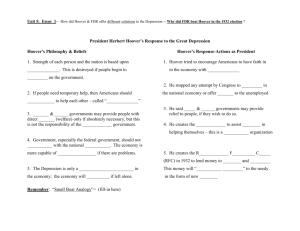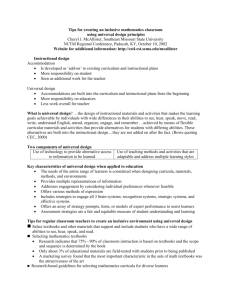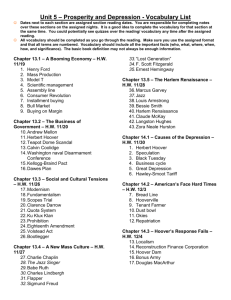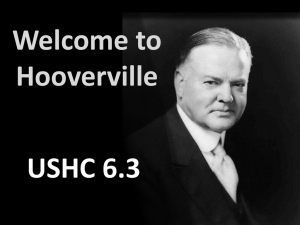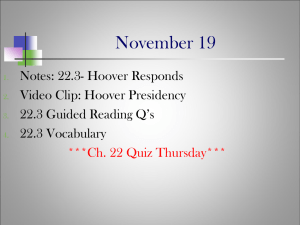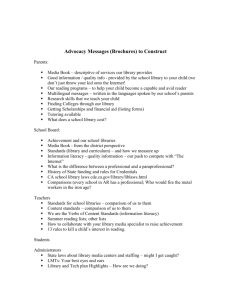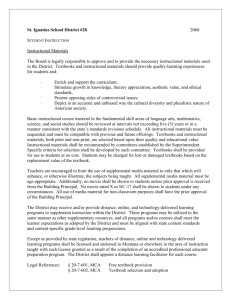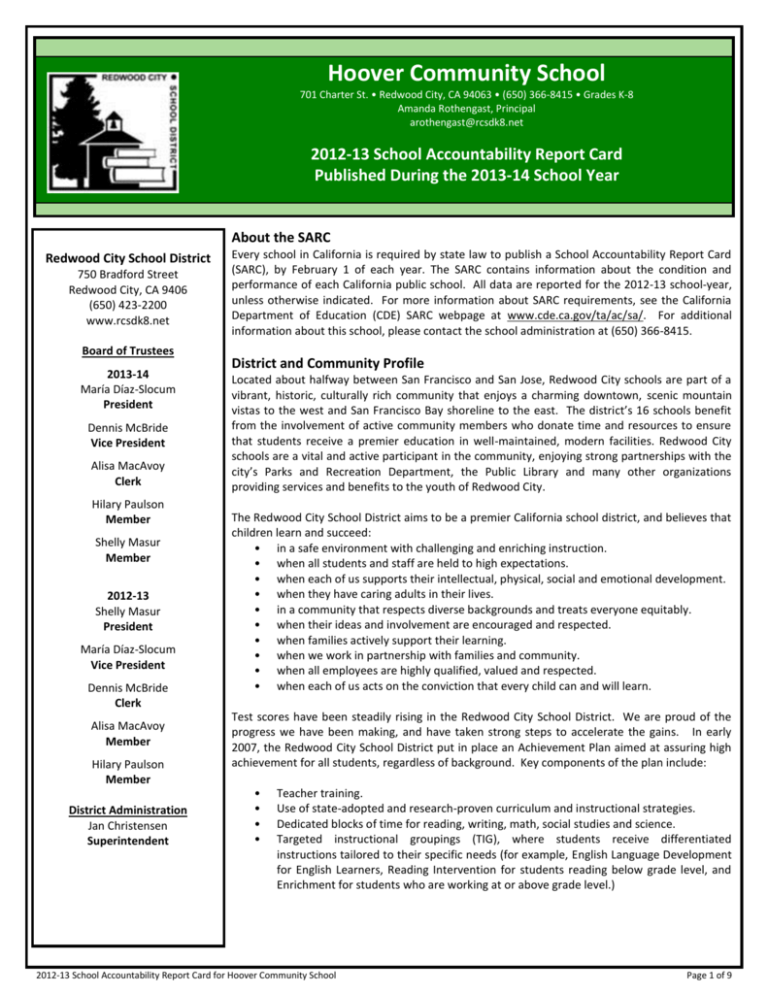
----
Hoover Community School
701 Charter St. • Redwood City, CA 94063 • (650) 366-8415 • Grades K-8
Amanda Rothengast, Principal
arothengast@rcsdk8.net
2012-13 School Accountability Report Card
Published During the 2013-14 School Year
----
About the SARC
Redwood City School District
750 Bradford Street
Redwood City, CA 9406
(650) 423-2200
www.rcsdk8.net
Board of Trustees
2013-14
María Díaz-Slocum
President
Dennis McBride
Vice President
Alisa MacAvoy
Clerk
Hilary Paulson
Member
Shelly Masur
Member
2012-13
Shelly Masur
President
María Díaz-Slocum
Vice President
Dennis McBride
Clerk
Alisa MacAvoy
Member
Hilary Paulson
Member
District Administration
Jan Christensen
Superintendent
Every school in California is required by state law to publish a School Accountability Report Card
(SARC), by February 1 of each year. The SARC contains information about the condition and
performance of each California public school. All data are reported for the 2012-13 school-year,
unless otherwise indicated. For more information about SARC requirements, see the California
Department of Education (CDE) SARC webpage at www.cde.ca.gov/ta/ac/sa/. For additional
information about this school, please contact the school administration at (650) 366-8415.
District and Community Profile
Located about halfway between San Francisco and San Jose, Redwood City schools are part of a
vibrant, historic, culturally rich community that enjoys a charming downtown, scenic mountain
vistas to the west and San Francisco Bay shoreline to the east. The district’s 16 schools benefit
from the involvement of active community members who donate time and resources to ensure
that students receive a premier education in well-maintained, modern facilities. Redwood City
schools are a vital and active participant in the community, enjoying strong partnerships with the
city’s Parks and Recreation Department, the Public Library and many other organizations
providing services and benefits to the youth of Redwood City.
The Redwood City School District aims to be a premier California school district, and believes that
children learn and succeed:
• in a safe environment with challenging and enriching instruction.
• when all students and staff are held to high expectations.
• when each of us supports their intellectual, physical, social and emotional development.
• when they have caring adults in their lives.
• in a community that respects diverse backgrounds and treats everyone equitably.
• when their ideas and involvement are encouraged and respected.
• when families actively support their learning.
• when we work in partnership with families and community.
• when all employees are highly qualified, valued and respected.
• when each of us acts on the conviction that every child can and will learn.
Test scores have been steadily rising in the Redwood City School District. We are proud of the
progress we have been making, and have taken strong steps to accelerate the gains. In early
2007, the Redwood City School District put in place an Achievement Plan aimed at assuring high
achievement for all students, regardless of background. Key components of the plan include:
•
•
•
•
Teacher training.
Use of state-adopted and research-proven curriculum and instructional strategies.
Dedicated blocks of time for reading, writing, math, social studies and science.
Targeted instructional groupings (TIG), where students receive differentiated
instructions tailored to their specific needs (for example, English Language Development
for English Learners, Reading Intervention for students reading below grade level, and
Enrichment for students who are working at or above grade level.)
2012-13 School Accountability Report Card for Hoover Community School
Page 1 of 9
School Mission Statement
Our mission is to prepare our students for 21st century careers where our students learn with direct instruction, thinking critically,
collaborating, and integrating technology in their daily work. The Hoover Community is committed to working together to provide a
joyful, safe and caring learning environment that is based on mutual respect.
School Profile
Hoover Community School is the most populated school in the Redwood City School District with 850 students in Kinder to 8th Grade.
Seventy five percent of our kinder students participate in our Spanish and English bilingual program. We continue to celebrate and
recognize our students' bilingual skills throughout their school years. As a Community School, the school, families, and community
partners work together to support the whole child and their families. During the school day, we provide rigorous academics, focused on
grade level mastery every day. Outside of the classroom, our community partners offer multiple services to support the entire family.
Our joyful, safe and caring learning environment continues to thrive with the focused efforts of our staff, parents, students and
community.
Opportunities for Parental Involvement
Parents play an important role at Hoover Community School through active participation and involvement in the School Site Council, the
Principal's Monthly Cafecito/Coffee, Community Mobilization Team and the English Language Advisory Committee (ELAC). Parents and
community members are also encouraged to volunteer in classrooms and guide school projects like our Walking School Bus. Many of
our parents also participate in our parent education and adult education classes. We collaborate with our parents in planning our
holistic services such as our food support, mental health resources and extended day programs for students.
Hoover Community School is proud of its strong partnerships with the following community businesses: Costco, Wells Fargo, the TOSA
Foundation and the Sobrato Foundation.
Parents who wish to participate in Hoover’s leadership teams, school committees, school activities, or become a volunteer may contact
the school at (650) 366-8415. The school’s website (http://www.rcsdk8.net/hoover/) also provides a variety of helpful resources and
information about the school and includes our monthly calendar.
Student Enrollment by Group
Student Enrollment by Grade Level
Grade Level
Number of Students
Group
Percent of Total Enrollment
Black or African American-------
0.2
0.2
119
American Indian or Alaska Native-----Asian-------
Gr. 2--
109
Filipino-------
0.1
Gr. 3--
88
Hispanic or Latino-------
95.0
Gr. 4--
110
Native Hawaiian/Pacific Islander
1.4
Gr. 5--
108
White
0.9
Gr. 6--
90
Two or More Races
0.3
Gr. 7--
82
Socioeconomically Disadvantaged
100.0
Gr. 8--
85
English Learners
92.0
Total--
880
Students with Disabilities
11.1
Kinder.
89
Gr. 1--
2012-13 School Accountability Report Card for Hoover Community School
1.8
Page 2 of 9
Average Class Size and Class Size Distribution
Average Class Size
Year
11
Kinder. 29.5
Suspensions and Expulsions
Number of Classrooms*
1-20
21-32
33+
13
Schoolwide
10-11
11-12
12-13
Suspensions Rate
14.99
12.5
10%
12
13
11
12
13
11
12
13
11
12
0.8
0
0%
26
22
0
1
1
4
4
3
0
0
Districtwide
10-11
11-12
12-13
Expulsions Rate
Gr. 1--
27.3 28.5
24
0
0
1
3
4
4
0
0
Suspensions Rate
5.88
6.2
Gr. 2--
26.3 25.3
22
1
1
2
3
2
3
0
0
Expulsions Rate
0.3
.25
Gr. 3--
26.8 27.4
18
1
1
2
4
4
3
0
0
22
0
0
2
4
3
3
0
0
22
0
0
2
3
4
3
0
0
Gr. 4-Gr. 5--
27
30
29.7 28.5
Gr. 6--
25
English 25.3 28.2
27
3
2
4
7
8
8
2
0
Math--- 25.8 27.7
27
2
1
4
3
5
8
1
0
Science
30.6
28
2
0
2
3
5
4
1
0
27.7 29.8
28
1
0
2
4
4
4
1
1
SS----*
27
5
*
The rate of suspensions and expulsions is calculated by dividing the total
number of incidents by the total enrollment (and multiplying by 100).
26
Number of classes indicates how many classrooms fall into each size category
(a range of total students per classroom). At the secondary school level, this
information is reported by subject area, English, Math, Science and Social
Science (SS), rather than grade level.
School Safety Plan
This section provides information about the school’s comprehensive safety plan, including the dates on which the safety plan was last reviewed,
updated, and discussed with faculty; as well as a brief description of the key elements of the plan.
The School Site Safety plan is evaluated and revised annually in the spring by members of the School Site Council. Revisions to the Safety Plan are
communicated to all staff members annually. Key elements of the Safety Plan include: location of emergency supplies in each wing and staff members’
assigned duties during a disaster. The school is in compliance with the laws, rules, and regulations pertaining to hazardous materials and state
earthquake standards. The school’s disaster preparedness plan includes steps for ensuring student and staff safety during an emergency. Fire drills are
held monthly, earthquake drills are held once a year and lockdown drills are held once a year.
Safety of students and staff is a primary concern of Hoover School. To ensure student safety, supervision is provided on campus at all times. Teachers
and administrators supervise students before and after school and during breaks. All visitors to the school must sign in and out at the office, and must
have prior authorization for classroom visits.
Hoover has a proactive school-wide discipline committee that meets monthly with a focus on the school climate. At the heart of this plan is the belief
that all students are entitled to learn in a safe and caring environment that not only promotes high expectations for academic growth, but also offers
students a sense of confidence to freely take the academic risks that make that growth possible. Through our collaboration as a learning community,
all of our students will learn the skills that will help them find their greatest potential as learners and citizens.
School Facility Conditions and Planned Improvements (School Year 2013-14)
This section provides information from the most recent Facility Inspection Tool (FIT) data (or equivalent), including:
•
Description of the safety, cleanliness, and adequacy of the school facility
•
Description of any planned or recently completed facility improvements
•
The year and month in which the data were collected
•
Description of any needed maintenance to ensure good repair
Year and month in which data were collected: September 20, 2011
Hoover Community School was originally constructed in the 1950s and is currently comprised of 47 classrooms, one computer lab, one library, one
science laboratory, one multi-purpose room, one staff lounge, a playground, and a play field.
The school was completely modernized in 1998 and also passed two separate bond projects (Measures A & B). Measure A renovations included
technology and electrical upgrades. Measure B projects have been completed at variable times over the past three years and have included/will
include: installation of energy efficient lighting; remodeling of all restrooms; resurfacing of the parking lot, and playground/wings; replacing of window
coverings and sidewalks along Charter Street; the addition of a new parking area; improvements to the multipurpose room and kitchen area; and
campus-wide American Disabilities Act (ADA) improvements, and fencing repairs. Community partners have donated resources and materials to
recently renovate our staff room, computer lab and Family Center.
2012-13 School Accountability Report Card for Hoover Community School
Page 3 of 9
School Facility Good Repair Status (School Year 2013-14)
This section provides information from the most recent Facility Inspection Tool (FIT) data (or equivalent), including:
•
•
•
Determination of repair status for systems listed
Description of any needed maintenance to ensure good repair
The Overall Rating (bottom row)
School Facility Good Repair Status
System Inspected
Repair Status
Repair Needed and
Action Taken or Planned
Good
Fair
Poor
Systems:
Gas Leaks, Mechanical/HVAC, Sewer
[X]
[ ]
[ ]
Rooms 106, 206, 408, 409 and 604 have
materials blocking the return air register.
Correction to be completed by 1-13-12.
Interior:
Interior Surfaces
[X]
[ ]
[ ]
Room 603 Water damage on window sill.
WO 20621 completed 10-3-11.
Room 605 Pencil sharpener missing cover.
WO 22164 to be completed on or before
1-13-12.
Cleanliness:
Overall Cleanliness, Pest/ Vermin Infestation
[X]
[ ]
[ ]
Graffiti on play structure. WO 22165 to be
completed by 1-13-12.
Electrical:
Electrical
[X]
[ ]
[ ]
No issues
Restrooms/Fountains:
Restrooms, Sinks/ Fountains
[X]
[ ]
[ ]
No issues
Safety:
Fire Safety, Hazardous Materials
[X]
[ ]
[ ]
Assistant Principal, daisy chained surge
protectors. To be corrected by 1-13-12.
Room 206, electrical wire over the sink. To
be corrected by 1-13-12.
Room 206, high storage needs corrected.
To be corrected by 1-13-12.
Room 208, attach bookcase to wall. WO
22162 to be completed by 1-13-12.
Room 209, high storage needs corrected.
To be corrected by 1-13-12.
Room 309, high storage needs corrected.
To be corrected by 1-13-12.
Room 408, high storage needs corrected.
To be corrected by 1-13-12.
Room 409, high storage needs corrected.
To be corrected by 1-13-12.
Room 507, high storage needs corrected.
To be corrected by 1-13-12.
Room 509, high storage needs corrected.
To be corrected by 1-13-12.
Room 604, daisy chained surge protectors.
To be corrected by 1-13-12.
Room 601, unstable household lamps. To
be corrected by 1-13-12.
Structural:
Structural Damage, Roofs
[X]
[ ]
[ ]
No issues
External:
Playground/School Grounds, Windows/
Doors/Gates/Fences
[X]
[ ]
[ ]
No issues
Overall Rating
Exemplary
Good
Fair
Poor
[ ]
[X]
[ ]
[ ]
2012-13 School Accountability Report Card for Hoover Community School
Page 4 of 9
Teacher Credentials
Schoolwide
Teacher Misassignments and Vacant Teacher Positions at this School
10-11
11-12
12-13
Fully Credentialed
42
42
43
Without Full Credential
0
0
0
Teaching Outside Subject Area
0
0
Districtwide
10-11
11-12
Fully Credentialed
♦
♦
Without Full Credential
♦
♦
12-13
Schoolwide
11-12
12-13
13-14
Teachers of English Learners
0
0
0
Total Teacher Misassignments
0
0
0
Vacant Teacher Positions
0
0
0
*
“Misassignments” refers to the number of positions filled by teachers who
lack legal authorization to teach that grade level, subject area, student group,
etc.
Professional Development
This section provides information on the number of days provided for professional development and continuous professional growth in the most
recent three year period.
Staff members build teaching skills and concepts through participation in conferences and workshops throughout the year. For the past three years,
the District has sponsored three staff development days, where teachers are offered a variety of growth opportunities. Topics for staff development
during the 2012-13 school year included: Instructional Strategies for the Common Core Standards, Technology Integration in the classroom, Explicit
Direct Instruction, FOSS science kit training, Training, Reading Assessment Training for K-2 Teachers and English Language Development strategies. The
District also created an optional training program for teachers called RCSD University. This differentiated program allows teachers to choose workshops
based on topics they are interested in pursuing.
For additional support in their profession, teachers may enlist the services of the district’s Beginning Teacher Support and Assessment (BTSA) facilitator
and/or the Peer Assistance and Review (PAR) program.
Core Academic Classes Taught by Highly Qualified Teachers
The Federal Elementary and Secondary Education Act (ESEA), also known
as No Child Left Behind (NCLB), requires that core academic subjects be
taught by Highly Qualified Teachers, defined as having at least a
bachelor’s degree, an appropriate California teaching credential, and
demonstrated core academic subject area competence. For more
information, see the CDE Improving Teacher and Principal Quality
webpage at: www.cde.ca.gov/nclb/sr/tq/
Percent of Classes In Core Academic Subjects
Core Academic Classes Taught by Highly Qualified Teachers
Location of Classes
This School
Taught by Highly
Qualified Teachers
Not Taught by Highly
Qualified Teachers
100.0
0.0
Districtwide
Academic Counselors and Other Support Staff at this School
Number of Full-Time Equivalent (FTE)
Academic Counselor-------
0
Social/Behavioral or Career Development Counselor
0
Library Media Teacher (Librarian)
0
Library Media Services Staff (Paraprofessional)
0.7
Psychologist-------
0.6
Social Worker-------
0.4
Speech/Language/Hearing Specialist
0.6
Resource Specialist------Other-------
98.4
1.6
High-Poverty Schools
98.0
2.0
Academic Counselor-------
Low-Poverty Schools
100.0
0.0
*
High-poverty schools are defined as those schools with student eligibility of
approximately 40 percent or more in the free and reduced price meals
program. Low-poverty schools are those with student eligibility of
approximately 25 percent or less in the free and reduced price meals
program.
2012-13 School Accountability Report Card for Hoover Community School
0
4.5
All Schools
*
0
Nurse-------
Average Number of Students per Staff Member
0
One Full-Time Equivalent (FTE) equals one staff member working full-time;
one FTE could also represent two staff members who each work 50 percent
of full-time.
Page 5 of 9
Expenditures Per Pupil and School Site Teacher Salaries
(Fiscal Year 2011-12)
Teacher and Administrative Salaries (Fiscal Year 2011-12)
Category
District
Amount
State Average for
Districts In Same
Category
Total
Restricted
Unrestricted
Average
Teacher
Salary
Beginning Teacher Salary
$43,879
$41,451
School Site-----District------
$9,063
$4,113
$4,950
$71,114
Mid-Range Teacher Salary
$67,133
$67,655
♦
♦
$5,150
$70,965
-State-------
Highest Teacher Salary
$85,395
$85,989
♦
♦
$5,537
$70,193
Average Principal Salary (ES)
$112,619
$108,589
Percent Difference: School Site/District
-3.9
0.2
Average Principal Salary (MS)
$112,619
$111,643
Percent Difference: School Site/ State
-10.6
1.3
Average Principal Salary (HS)
$0
$110,257
$170,000
$182,548
Expenditures Per Pupil
Level
*
*
Supplemental/Restricted expenditures come from money whose use is
controlled by law or by a donor. Money that is designated for specific
purposes by the district or governing board is not considered restricted.
Basic/Unrestricted expenditures are from money whose use, except for
general guidelines, is not controlled by law or by a donor.
For detailed information on school expenditures for all districts in
California, see the CDE Current Expense of Education & Per-pupil
Spending webpage at www.cde.ca.gov/ds/fd/ec/. For information on
teacher salaries for all districts in California, see the CDE Certificated
Salaries & Benefits webpage at www.cde.ca.gov/ds/fd/cs/. To look up
expenditures and salaries for a specific school district, see the Ed-Data
Web site at: www.ed-data.org.
Superintendent Salary
Percent of District Budget
Teacher Salaries
38.6%
41.8%
Administrative Salaries
6.9%
5.5%
*
For detailed information on salaries, see the CDE Certificated Salaries &
Benefits webpage at www.cde.ca.gov/ds/fd/cs/.
Types of Services Funded (Fiscal Year 2012-13)
This section provides specific information about the types of programs and services available at the school that support and assists students. For
example, this narrative may include information about supplemental educational services related to the school’s federal Program Improvement (PI)
status.
Title I: Migrant Education
Title I: Even Start Migrant Education
Title IV: Drug Free Schools
Title II: Part A Teacher Quality
Title II: Principal Training
Title II: Part D Enhancing Education Through Technology
Title III: Immigrant Education Program
Title III: Limited English Proficiency
Medi-Cal Billing Option
Teacher Recruitment & Retention
Community Based English Tutoring Program
English Language Acquisition Program ("ELAP")
Lottery: Instructional Materials
School Safety & Violence Prevention
Tobacco-Use Prevention Education("TUPE" 4-8)
Economic Impact Aid ("LEP")
Economic Impact Aid ("SCE")
Gifted & Talented Education ("GATE")
Instructional Material Fund Realignment Program
Peer Assistance & Review Program ("PAR")
Targeted Instructional Improvement Block Grant
AB825 Beginning Teacher Support And Assessment ("BTSA")
AB825 Instructional Time and Staff Development Reform
AB825 School Improvement Program ("SIP")
Art, Music & PE Supplies & Equipment
Title I: Basic Grants Low Income
After School Education and Safety ("ASES")
School Community Violence Prevention Grant
2012-13 School Accountability Report Card for Hoover Community School
Page 6 of 9
Quality, Currency, Availability of Textbooks and Instructional Materials (School Year 2013-14)
This section describes whether the textbooks and instructional materials used at the school are from the most recent adoption; whether there are
sufficient textbooks and instruction materials for each student; and information about the school’s use of any supplemental curriculum or non-adopted
textbooks or instructional materials.
Year and month in which data were collected: September 2013
All Redwood City School District students have equal access to state adopted, standards aligned textbooks and instructional materials. Funds are
appropriated according to the textbook adoption cycle. Additional supplemental materials are purchased and made available to students. All
instructional materials are aligned to the standards and available for each student.
Pursuant to the settlement of Williams vs. the State of California, Redwood City School District thoroughly inspected each of its school sites at the start
of the 2013-2014 school year to determine whether or not each school had sufficient and good quality textbooks, instructional materials, and/or
science laboratory equipment. All students, including English Learners, are required to be given their own individual textbooks and/or instructional
materials (in the four core subject areas: English language arts, mathematics, history/social studies and science), for use in the classroom and to take
home if necessary. Additionally, all textbooks and instructional materials used within the District must be aligned with the California State Content
Standards and Frameworks, with final approval by the State Board of Education.
The Redwood City School District Textbook selection is done by a District, grade level and subject area committees coordinated by the Deputy Assistant
Superintendent of Curriculum and Instruction. The final textbook selections for grades K-8 from the current approved State lists are then selected and
the recommendation goes before the School Board for final approval.
Additionally Hoover is using Scholastic English 3D Language and Writing program ©2006 as supplemental ELD materials.
The chart below displays data collected during the August 2013 District Textbook Audit, in regards to student editions in use at Hoover School during
the current school year (2013-14).
Textbooks and Instructional Materials
Core Curriculum Area
Textbooks and Instructional Materials/Year of Adoption
Reading/Language Arts
The textbooks listed are
Yes
from most recent adoption:
Percent of students lacking 0%
their own assigned
textbook:
Houghton Mifflin California Reading Medallion Edition ©2010, Kindergarten through 5th Grade – State Approved,
Board Adopted in 2009
Mathematics
The textbooks listed are
Yes
from most recent adoption:
Percent of students lacking 0%
their own assigned
textbook:
Macmillan / McGraw – Hill California Mathematics, Concepts Skills and Problem Solving ©2009, Kindergarten
through 6th grade – State Approved, Board Adopted in 2009
Pearson Literature for California & Language Central ©2010, 6th grade through 8th grade – State Approved,
Board Adopted in 2009
Inside Language, Literacy and Content ©2006, (4th grade through 8th grade Intervention / English Language
Development) – State Approved 2008
Glencoe / McGraw – Hill California Mathematics Concepts, Skills & Problem Solving ©2008, Pre-Algebra – State
Approved, Board Adopted 2009
Pearson Prentice Hall Algebra 1 Classic, Smith Charles ©2008 – State Approved, Board Adopted 2009
Prentice Hall Geometry, California Edition ©2007
Science
The textbooks listed are
from most recent adoption:
Percent of students lacking
their own assigned
textbook:
History-Social Science
The textbooks listed are
from most recent adoption:
Percent of students lacking
their own assigned
textbook:
Yes
0%
Yes
0%
Full Option Science System (FOSS) Delta Education, Inc. ©2007, Kindergarten through 5th grade – State Approved,
Board Adopted 2008
CPO Science - Focus on Earth/Life/Physical ©2007, 6th grade through 8th grade – State Approved, Board Adopted
in 2007
Macmillan / McGraw – Hill California Vistas ©2005, Kindergarten through 5th Grade – State Approved, Board
Adopted in 2006
Teachers' Curriculum Institute, History Alive! ©2004/2005, 6th grade through 8th grade – State Approved, Board
Adopted in 2006
2012-13 School Accountability Report Card for Hoover Community School
Page 7 of 9
Note: Scores are not shown when the number of students tested is ten or
less, either because the number of students in this category is too small
for statistical accuracy or to protect student privacy.
The Standardized Testing and Reporting (STAR) Program consists of
several key components, including:
•
California Standards Tests (CSTs), which include Englishlanguage arts (ELA) and mathematics (Math) in grades two through
eleven; science in grades five, eight, and nine through eleven; and
history-social science (H-SS) in grades eight, and nine through
eleven.
•
California Modified Assessment (CMA), an alternate
assessment that is based on modified achievement standards in ELA
for grades three through eleven; mathematics for grades three
through seven, Algebra I, and Geometry; and science in grades five
and eight, and Life Science in grade ten. The CMA is designed to
assess those students whose disabilities preclude them from
achieving grade-level proficiency on an assessment of the California
content standards with or without accommodations.
•
California Alternate Performance Assessment (CAPA),
includes ELA and mathematics in grades two through eleven, and
science for grades five, eight, and ten. The CAPA is given to those
students with significant cognitive disabilities whose disabilities
prevent them from taking either the CSTs with accommodations or
modifications or the CMA with accommodations.
Internet Access
Internet access is available at public libraries and other locations that are
publicly accessible. Access to the Internet at libraries and public locations
is generally provided on a first-come, first-served basis. Other use
restrictions may include the hours of operation, the length of time that a
workstation may be used (depending on availability), the types of
software programs available on a workstation, and the ability to print
documents.
2013 STAR Results by Student Group
Group
Percent of Students Scoring at
Proficient or Advanced
ELA
Math
Science
H-SS
All Students in the LEA
51
57
53
47
All Student at the School
34
53
47
69
Male-------
31
52
49
78
Female-------
37
54
45
63
34
52
47
68
Socioeconomically Disadvantaged
34
53
48
69
English Learners-------
14
44
13
8
Students with Disabilities
20
30
Students Receiving Migrant
Education Services
33
53
Black or African American
American Indian or Alaska Native
Asian------Filipino-------
The assessments under the STAR Program show how well students are
doing in relation to the state content standards. On each of these
assessments, student scores are reported as performance levels.
Hispanic or Latino
Native Hawaiian/Pacific Islander
White-------
For detailed information regarding the STAR Program results for each
grade and performance level, including the Percent of Students not
tested, see the CDE STAR Results Web site at star.cde.ca.gov.
STAR Results for All Students - Three-Year Comparison
Percent of Students Scoring at Proficient or Advanced
Subject
School
District
State
Two or More Races-------
10-11 11-12 12-13 10-11 11-12 12-13 10-11 11-12 12-13
ELA----
36
38
34
49
53
51
54
56
55
Math---
52
57
53
56
59
57
49
50
50
Science
36
41
47
50
54
52
57
60
59
H-SS---
44
51
69
43
45
47
48
49
49
2012-13 School Accountability Report Card for Hoover Community School
Page 8 of 9
Academic Performance Index
API Growth by Student Group - 2013 Growth API Comparison
The Academic Performance Index (API) is an annual measure of state
academic performance and progress of schools in California. API scores
range from 200 to 1,000, with a statewide target of 800. For detailed
information about the API, see the CDE API webpage at
www.cde.ca.gov/ta/ac/ap/.
This table displays, by student group, the number of students included in
the API and the 2013 Growth API (API-G) at the school, district, and state
level.
API Growth by Student Group – Three-Year Comparison
Actual API Change
Group
All Students at the School
10-11
11-12
12-13
21
18
-9
Black or African American
American Indian or Alaska Native
Asian-------
Group
School
District
State
All Students
at the School
Students
642
6,838
4,655,989
API-G
737
783
790
Black or
African American
Students
2
100
296,463
773
708
API-G
American Indian or Students
Alaska Native
API-G
2
Asian-------
10
Students
13
30,394
749
743
177
406,527
916
906
1
79
121,054
API-G
Filipino------Hispanic or Latino
19
19
-12
Native Hawaiian/Pacific Islander
White------Two or More Races
Socioeconomically Disadvantaged
11
26
-9
English Learners
18
14
-14
Students with Disabilities
Students
882
867
Hispanic
or Latino
API-G
Students
609
4,934
2,438,951
API-G
735
742
744
Native Hawaiian/
Pacific Islander
Students
10
105
25,351
766
774
White-------
Students
1,337
1,200,127
905
853
91
125,025
894
824
4,831
2,774,640
API-G
6
API-G
Academic Performance Index Ranks - Three-Year Comparison
This table displays the school’s statewide and similar schools’ API ranks.
The statewide API rank ranges from 1 to 10. A statewide rank of 1 means
that the school has an API score in the lowest ten percent of all schools in
the state, while a statewide rank of 10 means that the school has an API
score in the highest ten percent of all schools in the state. The similar
schools API rank reflects how a school compares to 100 statistically
matched “similar schools.” A similar schools rank of 1 means that the
school’s academic performance is comparable to the lowest performing
ten schools of the 100 similar schools, while a similar schools rank of 10
means that the school’s academic performance is better than at least 90
of the 100 similar schools.
Academic Performance Index Ranks - Three-Year Comparison
API Rank
Filipino-------
2010
2011
2012
Statewide-------
1
2
2
Similar Schools-------
5
2
7
Federal Intervention Program (School Year 2013-14)
Schools and districts receiving federal Title I funding enter Program
Improvement (PI) if they do not make AYP for two consecutive years in
the same content area (ELA or mathematics) or on the same indicator
(API or graduation rate). After entering PI, schools and districts advance
to the next level of intervention with each additional year that they do
not make AYP. For detailed information about PI identification, see the
CDE
PI
Status
Determinations
webpage:
www.cde.ca.gov/ta/ac/ay/tidetermine.asp.
Indicator
Program Improvement Status
First Year of Program Improvement
Year in Program Improvement
School
District
In PI
In PI
2006-2007
2008-2009
Year 5
Year 3
Number of Schools Currently in Program Improvement
11
Percent of Schools Currently in Program Improvement
91.7
2012-13 School Accountability Report Card for Hoover Community School
Two
or More Races
Students
2
Socioeconomically
Disadvantaged
Students
642
API-G
737
734
743
English Learners
Students
568
4,056
1,482,316
API-G
717
710
721
Students
86
1,020
527,476
API-G
613
651
615
API-G
Students
with Disabilities
Adequate Yearly Progress
The federal ESEA requires that all schools and districts meet the following
Adequate Yearly Progress (AYP) criteria:
•
Participation rate on the state’s standards-based assessments in ELA
and mathematics
•
Percent proficient on the state’s standards-based assessments in
ELA and mathematics
•
API as an additional indicator
•
Graduation rate (for secondary schools)
Detailed information about AYP, can be found at the CDE Adequate
Yearly Progress (AYP) webpage at www.cde.ca.gov/ta/ac/ay/.
AYP Criteria
School
District
Made AYP Overall
No
No
Met Participation Rate: English-Language Arts
Yes
Yes
Met Participation Rate: Mathematics
Yes
Yes
Met Percent Proficient: English-Language Arts
No
No
Met Percent Proficient: Mathematics
No
No
Met API Criteria
No
Yes
Met Graduation Rate (if applicable)
N/A
N/A
Page 9 of 9

